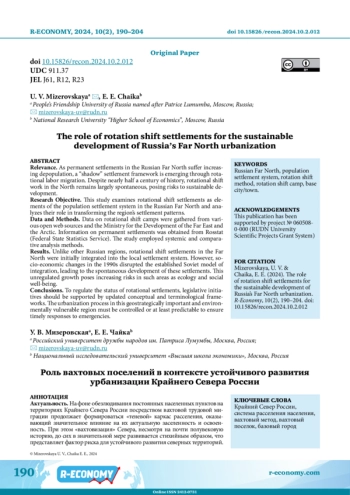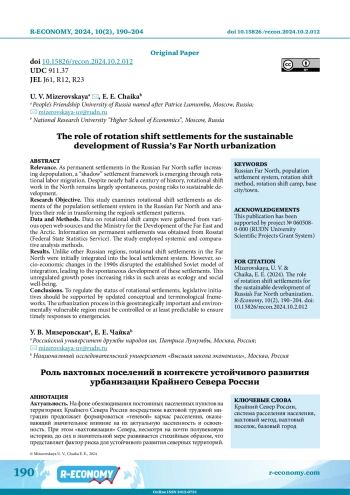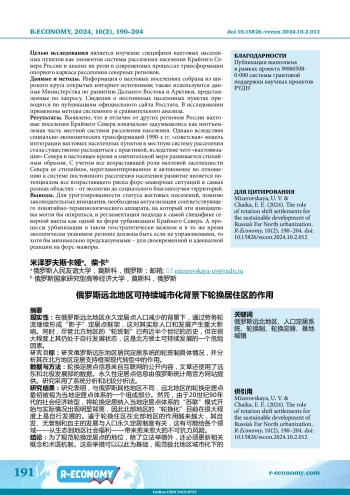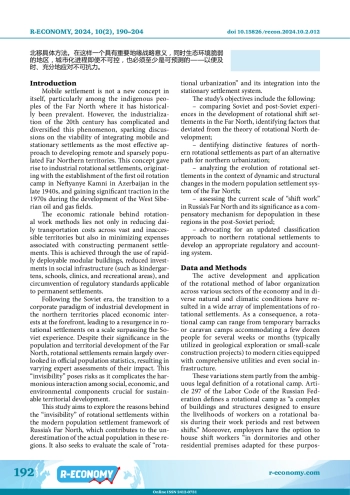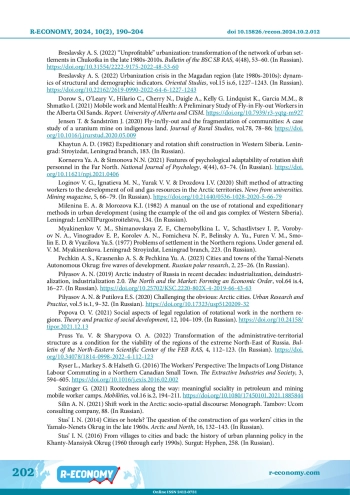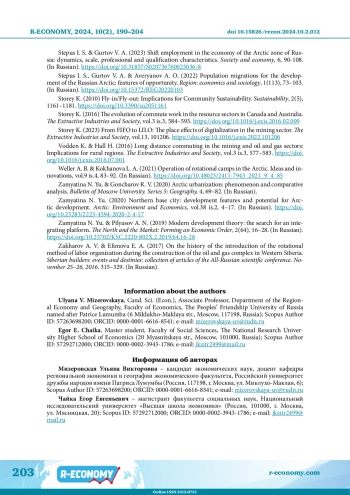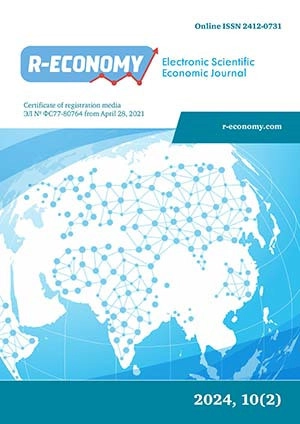Relevance. As permanent settlements in the Russian Far North suffer increasing depopulation, a “shadow” settlement framework is emerging through rotational labor migration. Despite nearly half a century of history, rotational shift work in the North remains largely spontaneous, posing risks to sustainable development. Research Objective. This study examines rotational shift settlements as elements of the population settlement system in the Russian Far North and analyzes their role in transforming the region’s settlement patterns. Data and Methods. Data on rotational shift camps were gathered from various open web sources and the Ministry for the Development of the Far East and the Arctic. Information on permanent settlements was obtained from Rosstat (Federal State Statistics Service). The study employed systemic and comparative analysis methods. Results. Unlike other Russian regions, rotational shift settlements in the Far North were initially integrated into the local settlement system. However, socio-economic changes in the 1990s disrupted the established Soviet model of integration, leading to the spontaneous development of these settlements. This unregulated growth poses increasing risks in such areas as ecology and social well-being. Conclusions. To regulate the status of rotational settlements, legislative initiatives should be supported by updated conceptual and terminological frameworks. The urbanization process in this geostrategically important and environmentally vulnerable region must be controlled or at least predictable to ensure timely responses to emergencies.
Идентификаторы и классификаторы
Mobile settlement is not a new concept in itself, particularly among the indigenous peoples of the Far North where it has historically been prevalent. However, the industrialization of the 20th century has complicated and diversified this phenomenon, sparking discussions on the viability of integrating mobile and stationary settlements as the most effective approach to developing remote and sparsely populated Far Northern territories. This concept gave rise to industrial rotational settlements, originating with the establishment of the first oil rotation camp in Neftyanye Kamni in Azerbaijan in the late 1940s, and gaining significant traction in the 1970s during the development of the West Siberian oil and gas fields.
Список литературы
1. Anisimovets A. D. (2017). History of urban development and prospects for the development of the territory of the Yamalo-Nenets Autonomous Okrug. Proceedings of the Moscow Architectural Institute: Proceedings of the international scientific and practical conference “Science, education and experimental design”. April 03-07, 2017. Collection of articles, 52-55. (In Russian).
2. Baburin V. L., Zemtsov S. P. (2015). The evolution of the system of urban settlements and the dynamics of natural and socio-economic processes in the Russian Arctic. Regional studies, 50, 4, 76-83. (In Russian).
3. Bazhutova E. A. (2022) Rotation shift as a reserve for the transformation of migration processes in the regions of the Arctic zone of the Russian Federation. The North and the Market: Forming an Economic Order, 4, 148-166. (In Russian). DOI: 10.37614/2220-802X.4.2022.78.011 EDN: FVHKDZ
4. Blagodeteleva O. M. (2017) Urban planning aspects of rotational development of northern and Arctic territories. Construction and reconstruction, 2, 71-84. (In Russian). EDN: ZAGQDT
5. Breslavsky A. S. (2022) “Unprofitable” urbanization: transformation of the network of urban settlements in Chukotka in the late 1980s-2010s. Bulletin of the BSC SB RAS, 4(48), 53-60. (In Russian). DOI: 10.31554/2222-9175-2022-48-53-60
6. Breslavsky A. S. (2022) Urbanization crisis in the Magadan region (late 1980s-2010s): dynamics of structural and demographic indicators. Oriental Studies, vol.15 is.6, 1227-1243. (In Russian). DOI: 10.22162/2619-0990-2022-64-6-1227-1243 EDN: RXZKZV
7. Dorow S., O’Leary V., Hilario C., Cherry N., Daigle A., Kelly G. Lindquist K., Garcia M. M., Shmatko I. (2021) Mobile work and Mental Health: A Preliminary Study of Fly-in Fly-out Workers in the Alberta Oil Sands. Report. University of Alberta and CISM. DOI: 10.7939/r3-yqtg-m927
8. Jensen T., Sandström J. (2020) Fly-in/fly-out and the fragmentation of communities: A case study of a uranium mine on indigenous land. Journal of Rural Studies, vol.78, 78-86;. DOI: 10.1016/j.jrurstud.2020.05.009 EDN: SLBPYX
9. Khaytun A. D. (1982) Expeditionary and rotation shift construction in Western Siberia. Leningrad: Stroyizdat, Leningrad branch, 183. (In Russian).
10. Korneeva Ya. A., Simonova N. N. (2021) Features of psychological adaptability of rotation shift personnel in the Far North. National Journal of Psychology, 4(44), 63-74. (In Russian). https://doi. org/. DOI: 10.11621/npj.2021.0406
11. Loginov V. G., Ignatieva M. N., Yurak V. V., Drozdova I. V. (2020) Shift method of attracting workers to the development of oil and gas resources in the Arctic territories. News from universities. Mining magazine, 5, 66-79. (In Russian). DOI: 10.21440/0536-1028-2020-5-66-79 EDN: RXLATX
12. Milenina E. A., Morozova K. I. (1982) A manual on the use of rotational and expeditionary methods in urban development (using the example of the oil and gas complex of Western Siberia). Leningrad: LenNIIPurgostroitelstva, 134. (In Russian).
13. Myakinenkov V. M., Shimanovskaya Z. F., Chernobylkina L. V., Schastlivtsev I. P., Vorobyov N. A., Vinogradov E. P., Korolev A. N., Fomicheva N. P., Belinsky A. Yu., Furen V. M., Smolin E. D., Vyazilova Yu. S. (1977) Problems of settlement in the Northern regions. Under general ed. V. M. Myakinenkova. Leningrad: Stroyizdat, Leningrad branch, 223. (In Russian).
14. Pechkin A. S., Krasnenko A. S., Pechkina Yu. A. (2023) Cities and towns of the Yamal-Nenets Autonomous Okrug: five waves of development. Russian polar research, 2, 25-26. (In Russian).
15. Pilyasov A. N. (2019) Arctic industry of Russia in recent decades: industrialization, deindustrialization, industrialization 2.0. The North and the Market: Forming an Economic Order, vol.64 is.4, 16-27. (In Russian). DOI: 10.25702/KSC.2220-802X-4-2019-66-43-63 EDN: MHXYIH
16. Pilyasov A. N., Putilova E. S. (2020) Challenging the obvious: Arctic cities. Urban Research and Practice, vol.5 is.1, 9-32. (In Russian). DOI: 10.17323/usp5120209-32 EDN: HAFHNU
17. Popova O. V. (2021) Social aspects of legal regulation of rotational work in the northern regions. Theory and practice of social development, 12, 104-109. (In Russian). DOI: 10.24158/tipor.2021.12.13 EDN: ZMQUIT
18. Pruss Yu. V., Sharypova O. A. (2022) Transformation of the administrative-territorial structure as a condition for the viability of the regions of the extreme North-East of Russia. Bulletin of the North-Eastern Scientific Center of the FEB RAS, 4, 112-123. (In Russian). DOI: 10.34078/1814-0998-2022-4-112-123 EDN: HGCUZG
19. Ryser L., Markey S., Halseth G. (2016) The Workers’ Perspective: The Impacts of Long Distance Labour Commuting in a Northern Canadian Small Town. The Extractive Industries and Society, 3, 594-605. DOI: 10.1016/j.exis.2016.02.002 EDN: YWPLCF
20. Saxinger G. (2021) Rootedness along the way: meaningful sociality in petroleum and mining mobile worker camps. Mobilities, vol.16 is.2, 194-211. DOI: 10.1080/17450101.2021.1885844 EDN: BHIMXZ
21. Silin A. N. (2021) Shift work in the Arctic: socio-spatial discourse: Monograph. Tambov: Ucom consulting company, 88. (In Russian).
22. Stas’ I. N. (2014) Cities or hotels? The question of the construction of gas workers’ cities in the Yamalo-Nenets Okrug in the late 1960s. Arctic and North, 16, 132-143. (In Russian). EDN: SHTOLF
23. Stas’ I. N. (2016) From villages to cities and back: the history of urban planning policy in the Khanty-Mansiysk Okrug (1960 through early 1990s). Surgut: Hyphen, 258. (In Russian).
24. Stepus I. S., Gurtov V. A. (2023) Shift employment in the economy of the Arctic zone of Russia: dynamics, scale, professional and qualification characteristics. Society and economy, 6, 90-108. (In Russian). DOI: 10.31857/S020736760025036-8 EDN: PNFNSM
25. Stepus I. S., Gurtov V. A., Averyanov A. O. (2022) Population migrations for the development of the Russian Arctic: features of opportunity. Region: economics and sociology, 1(113), 73-103. (In Russian). DOI: 10.15372/REG20220103 EDN: YUKDGM
26. Storey K. (2010) Fly-in/Fly-out: Implications for Community Sustainability. Sustainability, 2(5), 1161-1181. DOI: 10.3390/su2051161
27. Storey K. (2016) The evolution of commute work in the resource sectors in Canada and Australia. The Extractive Industries and Society, vol.3 is.3, 584-593. DOI: 10.1016/j.exis.2016.02.009
28. Storey K. (2023) From FIFO to LILO: The place effects of digitalization in the mining sector. The Extractive Industries and Society, vol.13, 101206. DOI: 10.1016/j.exis.2022.101206
29. Vodden K., Hall H. (2016) Long distance commuting in the mining and oil and gas sectors: Implications for rural regions. The Extractive Industries and Society, vol.3 is.3, 577-583. DOI: 10.1016/j.exis.2016.07.001
30. Weller A. B., Kokhanova L. A. (2021) Operation of rotational camps in the Arctic. Ideas and innovations, vol.9 is.4, 83-92. (In Russian). DOI: 10.48023/2411-7943_2021_9_4_85
31. Zamyatina N. Yu., Goncharov R. V. (2020) Arctic urbanization: phenomenon and comparative analysis. Bulletin of Moscow University. Series 5: Geography, 4, 69-82. (In Russian). EDN: HJIBXR
32. Zamyatina N. Yu. (2020) Northern base city: development features and potential for Arctic development. Arctic: Environment and Economics, vol.38 is.2, 4-17. (In Russian). DOI: 10.25283/2223-4594-2020-2-4-17
33. Zamyatina N. Yu., Pilyasov A. N. (2019) Modern development theory: the search for an integrating platform. The North and the Market: Forming an Economic Order, 2(64), 16-28. (In Russian). DOI: 10.25702/KSC.2220-802X.2.2019.64.16-28 EDN: GFTVFI
34. Zakharov A. V., Efimova E. A. (2017) On the history of the introduction of the rotational method of labor organization during the construction of the oil and gas complex in Western Siberia. Siberian builders: events and destinies: collection of articles of the All-Russian scientific conference. November 25-26, 2016. 315-329. (In Russian).
Выпуск
Другие статьи выпуска
Relevance: The knowledge economy in developing countries like Russia and India is dynamic and ever-changing. By researching the relationship between intellectual capital and financial performance, banks can create plans to manage their intangible assets efficiently, improving their financial performance, spur more innovation, and providing them with a competitive advantage. Research objective. This research aims to study the impact of the intellectual capital of the top banking companies in Russia and India on their financial performance. This research will investigate the potential effects of the following knowledge economy quirks on the correlation between financial performance and intellectual capital. Data and methods. This study includes a sample of the top eleven Russian banking companies constituents of the Moscow index and equivalent number of Indian Banking companies constituents of National Stock Exchange of India from 2011 to 2022. PLS-PM analysis has been employed to identify the intellectual capital components that predict the firm’s performance and the effect of intellectual capital components on the firm’s financial performance. Results. The path model results validate the model fit and provide compelling evidence for the Intellectual Capital framework’s theoretical underpinnings. The study offers evidence from the Russian and the Indian banking sector that intellectual capital significantly impacts performance. Conclusions. It is focused on the new strategy the government has chosen regarding the associated intellectual property. Even if the financial structures under analysis are sound, impending competitive challenges will compel banking companies to pay more attention to intellectual capital. The knowledge stock derived from intellectual capital, as a proxy variable for a global perspective on banking intellectual capital, is the most substantial scientific evidence regarding intellectual capital (IC) in the banking industry.
Relevance. The paper explores interregional cooperation, examining the challenges of aligning spatial and innovation development in macro-regions, with a focus on two federal districts of Russia. The study assesses the potential of interregional cooperation among neighboring regions within a single federal district, as well as among more distant regions across different federal districts. Research Objective. The study aims to test two hypotheses: the first deals with the viability of imitation innovation strategies in peripheral regions of both intra and inter-federal districts. The second hypothesis concerns the presence of innovation interdependence (autocorrelation) among regions from different federal districts, influenced by the level and industrial compatibility of innovation outputs. Data and methods. The study employs the DEA method to identify central and peripheral regions (imitator regions) by calculating technical efficiency indicators. It also uses coupling interregional complementarity indexes to assess the potential for interregional cooperation in innovation and technological import substitution, considering the industrial profiles of the regions. Spatial autocorrelation is evaluated by using Moran’s Index to estimate the level of regional interdependence, factoring in the level and industry conformity of innovation output. The novelty of the proposed methodological approach lies in the application of interregional indexes of innovation complementarity as weighting coefficients in Moran’s Index calculation. Results. The study reveals a rise in spatial inequality, competition among regions, and constrained interregional innovation cooperation across federal districts. Geographical proximity currently plays a pivotal role in cooperation, with initial indications of a macro-regional space evolving through knowledge exchange. However, both hypotheses concerning imitation strategies and autocorrelation are only confirmed for regions within a single federal district. Conclusions. The findings of this study regarding spatial autocorrelation offer valuable insights for policymakers in the sphere of regional innovation.
Relevance. Intergovernmental budgetary regulation is pivotal for promoting territorial equalization and bridging socio-economic gaps among regions. It ensures equitable access to public goods for all citizens, irrespective of their location. The effective distribution of federal financial assistance, guided by the principles of budget federalism, is essential for maintaining macroeconomic stability and fostering sustainable socio-economic development on the national and regional levels. Research Objective. The study aims to assess the competitive positions of Russian regions within the distribution system of federal intergovernmental transfers. Method and Data. To investigate Russia’s system of intergovernmental transfers, the research employs statistical methods, including structural-dynamic, grouping, and graphical analysis, along with novel analytical tools like the dependence coefficient and income coefficient. The study encompasses data from 2015 to 2022, sourced from the Federal Treasury and Federal State Statistics Service (Rosstat). Results. The study analyzes the dynamics of transfers from the federal budget to regional budgets and shows significant transformations in the transfer structure, revealing a decrease in non-targeted transfers and an increase in targeted ones. The study also examines the differences between regions in the distribution of these transfers. Russian regions were grouped depending on the share of federal transfers in their total budget income and the average per capita income in their consolidated budget. The study introduces a novel methodological approach through the use of newly developed tools - the dependence coefficient and income coefficient - to evaluate regional competitiveness. Conclusion. Despite an overall increase in federal transfers, persistent regional disparities intensify competition for financial assistance. These findings can be of interest to policymakers at federal and regional levels, researchers, and educators in relevant fields.
Relevance. In the current economic climate, maintaining the integrity of regional economic space is crucial. This involves ensuring uniform socio-economic development across regions and promoting a high rate of technology transfer from the center to the periphery. Therefore, it is essential to identify sustainable points of spatial development that represent centers of power concentration and guide spatial transformation. Research objective. The study aims to assess the connectivity of the region’s economic space by measuring population mobility. This approach will help identify the centers of social and labor communications that represent sustainable points of spatial development. The focus of the study is on the municipal districts of Sverdlovsk region, which are key elements of its economic space. Data and methods. The study employed geoinformation analysis of origin-destination matrix of population flows in Sverdlovsk region (Russian Federation), provided by Russian mobile operators. Results. The paper presents the analysis of intracity and intercity population flows based on the average daily data of mobile operators for 2022. The intensity and diversification of population flows in the region’s municipal districts, reflecting the connectivity of its economic space, were estimated using geographic information systems and the Python programming language. The study revealed that Sverdlovsk region has a bicentric system of spatial interconnections, with two distinct centers of attraction: Ekaterinburg and Nizhny Tagil, with Ekaterinburg being the dominant center. Conclusions. The proposed classification of municipal districts by the level of their inclusion into the economic space of Sverdlovsk region illustrates that only 5% are characterized by intensive and diversified inter-territorial interaction, while 34% are characterized by low indicators of intensity and diversification of mobile population flows. The spatial structure of the municipalities in Sverdlovsk region, which are located in the zone of attraction to the agglomeration centers, will be maintained and reinforced.
Relevance. Fostering well-being ranks high on regional social policy agendas. With the dynamic shifts in the international economic landscape, known as geo-economic fragmentation, there’s a pressing urgency for stakeholders to optimize resource allocation at the regional level, increasing interest in efficient strategies to adapt to sanctions while enhancing overall well-being. Research objective. This article aims to investigate the dimensions and determinants of the eco- and human capital efficiency in Russian regions in the context of geo-economic fragmentation and sanctions pressure. Data and methods. A proposed three-stage approach integrates factor analysis to identify subjective well-being indicators, data envelopment analysis (DEA) to evaluate socio-eco-efficiency, and panel tobit regression to examine the determinants of efficiency. Microdata from the Rossat Comprehensive Observation of Living Conditions database were utilized, covering the period from 2014 to 2022. To assess efficiency, a DEA model is employed. The output indicators from this model were the estimated measures of subjective well-being. These indicators were validated through factor analysis and included professional satisfaction, safety assessment, accessibility and quality of social and cultural infrastructure in the regions. Results. In the given period, people reported feeling increasingly satisfied with jobs and quality of life, though there was a noticeable slowdown in the growth of human capital development indicators, environmental investments, and real income by early 2023. Efficiency varied significantly among the regions. Industrially developed mining areas and republics in the North Caucasus consistently showed high socio-eco-efficiency, despite limited resources. The efficiency benefited both from digitalization and increased per capita gross regional product, but urbanization had a negative impact. Conclusions. Amid geo-economic fragmentation, regional communities and job markets face significant challenges in adaptation. With the looming risk of declining satisfaction and perceived quality of life, it is imperative for regional policies to bolster tangible well-being indicators and invest in social capital and infrastructure to address these issues effectively.
Relevance. Ensuring equal access to resources is crucial for social development, especially in rural areas. Women in these regions face distinct challenges due to traditional lifestyles and cultural norms, impacting their access to education, healthcare, and economic opportunities. Addressing these challenges is vital for the overall development of rural communities. Research objective. This study aims to develop methodological approaches to assessing women’s access to resources in rural areas of Kazakhstan. Data and methods. Based on the investigation of methodological approaches, multinomial logistic regression analysis was proposed to assess the impact of regional differences on gender gaps in access to various resources. The study is based on qualitative data collected from May to June 2023 from a sociological survey conducted among women aged 18-60 in rural settlements of Kazakhstan. A total of 600 respondents were interviewed, and 542 of the respondents had completed questionnaires. This methodology enables the collection, analysis, and processing of primary data, aiding in the assessment of gender disparities in resource access. Results. The proposed methodology facilitated a thorough analysis of qualitative data, offering insights into the problem of gender disparities. Most respondents rated their access to social and economic resources as average, suggesting that while there are available resources, they might not fully meet rural women’s needs or expectations in terms of level or quality. Conclusions. Regions like Akmola, Atyrau, Mangystau, North Kazakhstan, Turkestan, and Zhambyl show significant disparities in resource access, indicating regional inequalities. Addressing this gap necessitates collaborative efforts between government and businesses to enhance resource availability and broaden opportunities for rural women.
Статистика статьи
Статистика просмотров за 2025 год.
Издательство
- Издательство
- УрФУ
- Регион
- Россия, Екатеринбург
- Почтовый адрес
- 620002, Свердловская область, г. Екатеринбург, ул. Мира, д. 19
- Юр. адрес
- 620002, Свердловская область, г. Екатеринбург, ул. Мира, д. 19
- ФИО
- Кокшаров Виктор Анатольевич (Ректор)
- E-mail адрес
- rector@urfu.ru
- Контактный телефон
- +7 (343) 3754507
- Сайт
- https://urfu.ru/ru
